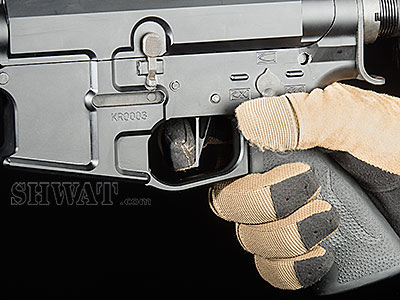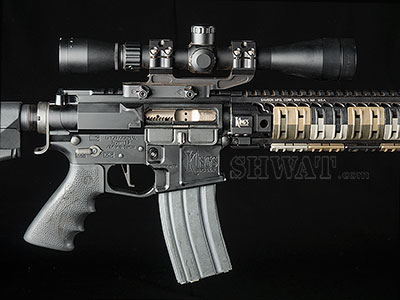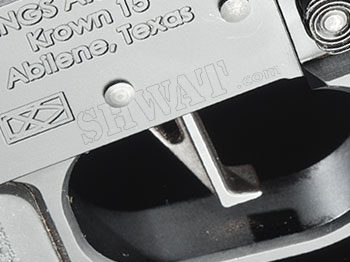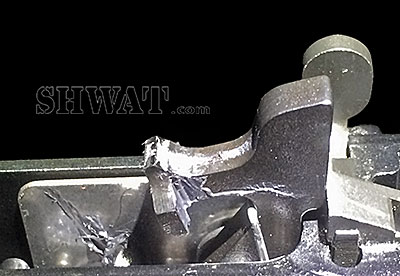I’ve been hunting for a trophy boar for months. I’ve seen it several times on the game camera, but never in person. Now, here I am after several hours of waiting, and here he is. He must be 350 pounds and has a serious set of tusks. Bringing my rifle up, I center my crosshairs a little high to send the bullet through the spine just behind his head. It’s a perfect broadside shot, but the range is a bit of a stretch. No margin for error at this distance. I gently press the trigger, then press a bit harder. A lot harder. The trigger begins to move one rough, gritty, little bit at a time. Then, BANG! The boar runs off because I moved ever so slightly while pulling that awful eight pound, mil-spec trigger.
 Okay, so that’s not how the story is supposed to go. Triggers are supposed to be smooth, breaking like glass, and bullets are supposed hit their mark. One of the most popular hog hunting guns – or any other kind of hunting gun for that matter – is the AR pattern rifle. Many of those come with triggers that aren’t worthy of the manufactures names that they bear, reducing the over-all potential and enjoyment of the rifle.
Okay, so that’s not how the story is supposed to go. Triggers are supposed to be smooth, breaking like glass, and bullets are supposed hit their mark. One of the most popular hog hunting guns – or any other kind of hunting gun for that matter – is the AR pattern rifle. Many of those come with triggers that aren’t worthy of the manufactures names that they bear, reducing the over-all potential and enjoyment of the rifle.
You can train to get better with a sub par trigger. That same trigger will probably smooth out a bit after sending a few thousand rounds downrange. That’s time and money that not every hunter has to allocate in the turning cash into gun smoke department.
 If it’s a good trigger you are after, why not just get a good trigger? It is one of the single most cost effective performance enhancing products available for an AR rifle. And you won’t get banned for life from competition like another Texas product – Lance Armstrong – for the extra performance. That’s a big bonus for me since I’m frequently found on a bicycle when I’m not doing something with guns.
If it’s a good trigger you are after, why not just get a good trigger? It is one of the single most cost effective performance enhancing products available for an AR rifle. And you won’t get banned for life from competition like another Texas product – Lance Armstrong – for the extra performance. That’s a big bonus for me since I’m frequently found on a bicycle when I’m not doing something with guns.
I know there are a few decent mil-spec triggers that come already installed on the rifle straight from the factory. I happen to own one of those. It’s amazing for what it is. But when you pull a truly nice trigger, it becomes clear what even a good mil-spec trigger isn’t.
Enter the CMC Triggers 2-Stage “multi-patent” trigger. Two stage triggers are preferred by some for precision shooting without giving up much – if any – of the fast performance of a single stage. They can also provide a lighter pull on the break than would be considered safe on most single stage triggers. Two stage triggers work by providing a sort of “set” before they break and fire the gun. CMC Triggers offers the two stage model in one pound/three pound and two pound/two pound varieties. I got the two pound/two pound Flat Trigger version.
 CMC triggers are the “drop in” type, meaning that once the pistol grip is loosened, selector/safety lever and the old trigger assembly removed, you simply drop your new CMC trigger assembly in. Then replace the safety lever, put the two supplied pins in, tighten your pistol grip, and you are done with the install. No springs to fool with, no filing, no screws to come loose, no gunsmithing. My trigger also came with CMC’s anti-walk pins, ensuring that everything stays in place long-term no matter how hard I run the gun. These pins are also easier to install than standard pins. Once you verify that your safety still works as designed, you are good to go. It couldn’t get any easier.
CMC triggers are the “drop in” type, meaning that once the pistol grip is loosened, selector/safety lever and the old trigger assembly removed, you simply drop your new CMC trigger assembly in. Then replace the safety lever, put the two supplied pins in, tighten your pistol grip, and you are done with the install. No springs to fool with, no filing, no screws to come loose, no gunsmithing. My trigger also came with CMC’s anti-walk pins, ensuring that everything stays in place long-term no matter how hard I run the gun. These pins are also easier to install than standard pins. Once you verify that your safety still works as designed, you are good to go. It couldn’t get any easier.
With my new trigger installed and the safety mechanism confirmed, it’s time to really get to know the trigger. Sure enough, it is super smooth and the break is clean and crisp. Just what you’d expect from CMC Triggers, one of the original drop in AR-15 trigger makers.
 The two pound/two pound weight is a great choice for the hunter. Two pounds of pressure gets the trigger moving. When the small amount of what some call “slack” is taken up, you feel the trigger stop. Another two pounds of pressure and it breaks, firing the gun. That makes for a trigger that allows for precise shooting and is still safe for carrying in the field. Quick initial and follow up shots are also possible by simply pulling straight through the first and second stage.
The two pound/two pound weight is a great choice for the hunter. Two pounds of pressure gets the trigger moving. When the small amount of what some call “slack” is taken up, you feel the trigger stop. Another two pounds of pressure and it breaks, firing the gun. That makes for a trigger that allows for precise shooting and is still safe for carrying in the field. Quick initial and follow up shots are also possible by simply pulling straight through the first and second stage.
Take-up and over-travel are managed by the design and shape/position of the internal parts. CMC believes their years of experience and customer feed-back has allowed them to optimize both, thus negating the need for user adjustment and maximizing reliability. I’d say they’ve done well with that concept.
The bottom line: if you want to shoot your AR type rifle more accurately, faster , with greater reliability and hot looks, and assuming you have an otherwise reasonable quality rifle, there is nothing else you can do to get there faster than installing a good trigger. And if you do want all that, then you should know that the CMC 2 Stage Flat Trigger is one of the best you can get. It’s a performance-enhancing drug for your gun. And yes, like Lance, if I had it to do all over again, I would. In the battle against feral hogs, go ahead and tell your furry foes to drop dead.



Does a trigger really make that big of a difference? Is a milspec trigger really that bad? Honestly if you need a lower weight trigger doesn’t that mean that you’re not an experienced or safe shooter?
A few years ago I got into this and had a few trigger jobs done but the gun never shot as well or reliably as just the factory trigger. With the passing of the years I just found lower weight triggers hard to control and more difficult to police my stance and grip around with tighter groups coming from medium heavy weights in the milspec range. Other than maybe some of the worst DA type triggers out there, like on old, cheap revolvers like the Russian Nagant (AWFUL!) it really shouldn’t matter what the trigger is like. But a lighter trigger is easier to unintentionally discharge in the field, more if it’s cold or you’re wearing gloves which is never an issue with a Milspec. I think it’s more reflective of shooter experience with time I can shoot most people’s guns better than they can and one of the least important factors that I can easily overlook or not notice is the trigger.
And let’s be honest with ourselves, if anything ever happens with the gun that becomes an issue be it an unintended discharge death/damage/injury resulting or a self defense occasion, that hair trigger (basically anything not factory) you installed is another noose the prosecution could use to hang you.
Not trying to be difficult but with all due respect an upgraded trigger seems to be a solution looking for a problem if not outright creating more problems than just dealing with stock milspec trigger. And there are some really nice ones out that cost very little like the PSA enhanced Milspec trigger or just whatever comes in most factory finished lowers from reputable companies like Spike’s, CMMG etc. BCM might make the nicest milspec I’ve ever tried but at those prices they can keep them.
Respectfully what do you think how do you feel about binary triggers..?
They can be fun, but useful? That’s debatable.
Your CMC 2.5lb trigger is as crisp as it gets.